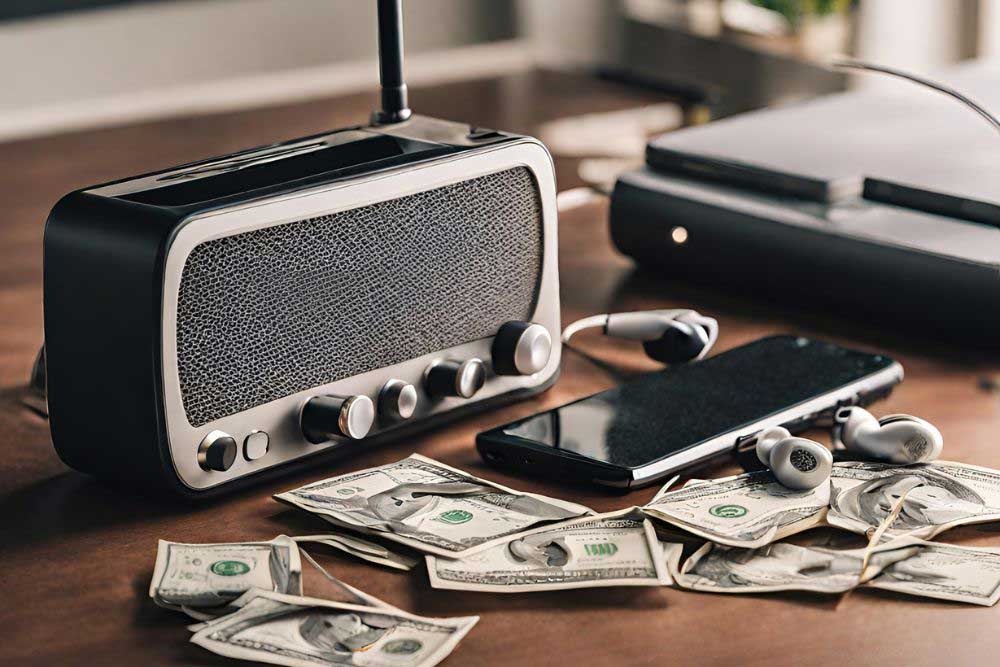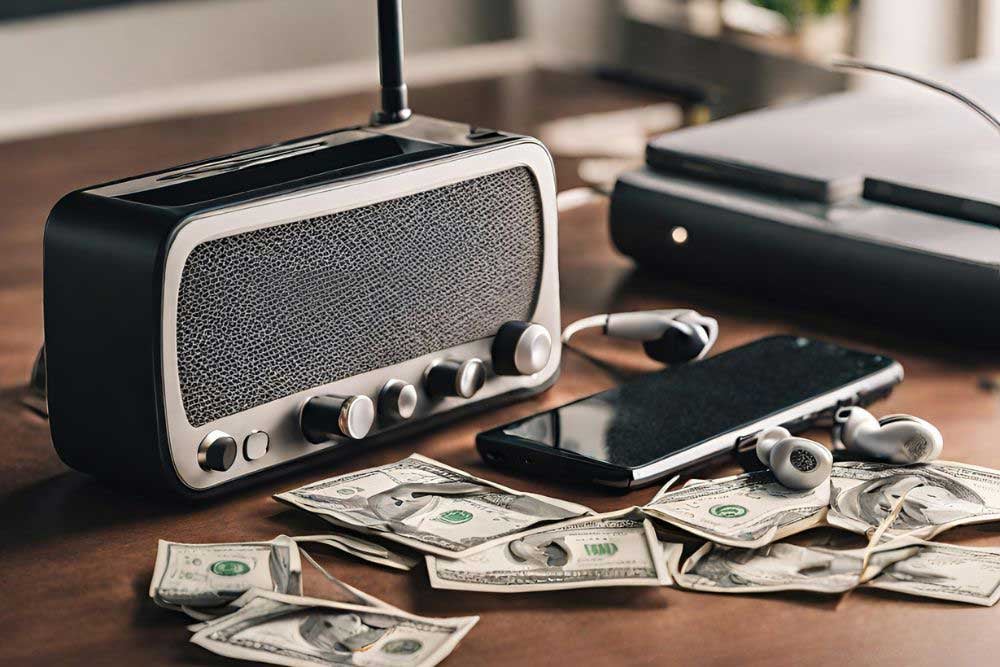Missouri Marketing Resource Blog

Understanding How Much It Costs to Advertise on Radio

Local radio advertising has been a cornerstone in the marketing mix for many years, serving as a reliable and effective medium for reaching out to target audiences. Even in today's digital age, where online marketing strategies seem to dominate, the charm and appeal of radio remain undiminished, particularly for businesses intent on making an impact within local or regional markets. However, a question that frequently arises among business owners and marketers delving into this realm for the first time is, 'How much does it cost to advertise on the radio?'
Understanding the cost for radio advertising is not straightforward, as it can vary widely depending on a multitude of factors. This blog aims to delve deeper into these variables, offering a comprehensive overview of what you might expect to budget for your radio advertising campaign, thereby enabling better planning and decision-making amidst these dynamics.
Radio Cost Factor 1: Supply and Demand.
Each radio station has a set amount of available inventory (airtime) for purchase by advertisers. Therefore, radio advertising prices are based on a supply-demand principle concerning the availability of advertisement slots at any given moment. When demand for these slots increases, particularly during peak times or popular seasons, the cost of securing an ad slot can rise substantially.
This is because many businesses and advertisers are competing for a limited amount of airtime, making the slots more valuable and sought after. As a result, the competition for advertisement space on a radio station can have a significant impact on the pricing of your advertisement, potentially making it more expensive to advertise during high-demand periods.
Radio Cost Factor 2: Length of the Ad
One of the primary determinants of your radio advertisement's cost is its duration. It follows a straightforward principle—the longer your advertisement runs, the more it will cost. For instance, a 30-second spot will be more economical than a 60-second spot due to the lesser amount of airtime it consumes. Therefore, planning your advertisement requires balancing effectively conveying your message and managing your expenditure to stay within budget constraints.
It's worth noting that advertisers configure the vast majority of radio advertisements to be 30 seconds in length. This duration has become an industry standard primarily because it strikes an ideal balance between allowing sufficient time for the advertiser to communicate a compelling message and minimizing listener fatigue. This 30-second format not only optimizes engagement but also aligns well with budget considerations, making it a popular choice among businesses of all sizes aiming to maximize their local market reach while adhering to financial constraints.
Radio Cost Factor 3: Purpose of the Ad
If a news sponsorship or weather sponsorship segment is associated with the advertisement, it will likely incur higher costs due to the premium positioning. Nonetheless, investors consider these types of sponsorships to be highly valuable. This is because they typically air during peak viewing or listening times, which means they attract a larger audience. As a result, despite the higher initial expense, the return on investment can be significant, thanks to the increased visibility and engagement from peak listenership.
Furthermore, campaigns that include live reads, endorsements or influencer campaigns will cost more because they carry a uniqueness that elevates them above a recorded commercial campaign. There are lots of ways to elevate a radio campaign and tap into elements that help your marketing messages stand out - a simple conversation with your marketing representative will uncover available strategies you can use.
Radio Cost Factor 4: Time of Day
Another critical factor to consider in the advertising world is the precise timing of your advertisement's broadcast, taking into account the concept of dayparts. Radio stations typically divide their schedule into five dayparts: 5am-10am, 10am-3pm, 3pm-7pm, 7pm-12midnight, and 12midnight-5am. Average radio advertising rates will therefore vary according to the time of day they air. Advertisements aired during prime listening times, such as the bustling morning (5am-10am) or evening rush hour (3pm-7pm), inevitably command a higher price than those broadcast during off-peak hours like 10am-3pm or the late night slot from 12midnight-5am.
The underlying rationale for this pricing strategy is straightforward yet compelling: a greater number of listeners during these peak dayparts translates directly into a larger pool of potential customers, and the demand for these times is high, reflecting their value in reaching a wider audience effectively.
Consequently, some advertisers are willing to pay a premium to access this expanded audience, despite the higher price tag associated with these coveted time slots. Thus, when planning an advertising campaign, it's crucial to weigh the benefits of reaching a larger audience against the increased cost of prime broadcasting times. Understand though, that it may only seem like the right choice. You may be able to accomplish more with less.
A Note on TAP Schedules
An often-overlooked aspect of local radio advertising is the value inherent in the Total Audience Plan (TAP). This approach acknowledges that the audience of a radio station extends beyond conventional daytime hours; indeed, communities like Columbia, Jefferson City, and Springfield have a robust overnight workforce and listening audience. This audience tunes in even during the less traditional overnight hours, presenting a unique opportunity for advertisers to connect with listeners around the clock.
By choosing a TAP schedule, advertisers can evenly distribute their messages across all five dayparts, covering both peak and off-peak listening times. This strategic dispersion not only maximizes the reach of your campaign but also offers an exceptional cost-efficiency advantage. You are no longer constrained to competing for the most expensive time slots to capture a significant audience. Instead, your ads gain consistent exposure throughout the day and night, engaging a wider audience that varies according to the time of day they are listening to the radio.
When you compare the value and reach to only running prime dayparts versus running a TAP schedule, the TAP schedule is by far the most cost-effective. Consequently, TAP schedules empower businesses to reach more people for less money, enhancing the overall value and effectiveness of their local radio advertising campaigns.
Radio Cost Factor 5: Length of the Campaign
The total length of time that your advertising campaign runs is a significant factor in how much it will cost. The right answer though depends on your goals.
Short-term action campaigns that aim to make a big impact in a brief period require a high concentration of ads in a short timeframe and a higher short-term investment. This increase in frequency, while requiring a larger initial investment, has the potential to significantly enhance the effectiveness of your advertising efforts and is very powerful for time-sensitive campaigns with a compelling offer or call to action.
On the other hand, spreading awareness campaigns over a longer period tends to make them more budget-friendly in the long term. You build frequency over the long term through consistency. This is a powerful branding strategy and requires long-term commitment to solidifying a brand presence over time.
Radio Cost Factor 6: Radio Station Audience
The demographics, including age, gender, and interests, as well as the overall size of the listening audience of a radio station, play a critical role in determining the advertising costs associated with that station. Stations that successfully attract larger or more specifically targeted audiences naturally experience higher demand for access to their audiences, and therefore have higher rates for their advertising slots.
Every radio station is different. Every radio station reaches a different target audience and has a slightly different audience size. It is super important to note that audience size is NOT an indicator of campaign success. You can achieve results on stations with smaller audiences just like you can on stations with large coverage areas and robust audiences. A variety of other factors come into play in helping determine your radio campaign success - but that’s a topic for another blog.
As you can see, there are multiple factors affecting local radio advertising costs. Pinpointing the exact cost of local radio advertising involves a nuanced understanding of several factors, from your ad's length and broadcast timing to the campaign's duration, frequency, and the chosen radio station's audience demographics. By carefully considering these elements, you can leverage the full potential of local radio to effectively reach your desired audience without overspending.
Our suggestion? Have an honest and thorough conversation with your marketing representative. Talk honestly about your campaign goals and your marketing budget. They will help you craft the right strategy that meets your objectives without breaking the bank.





